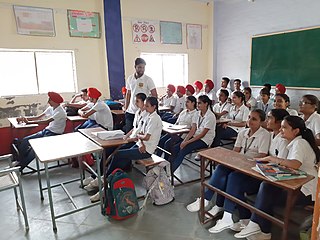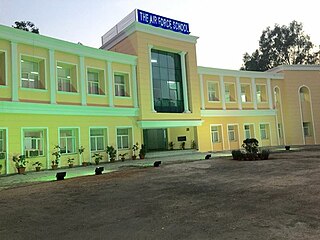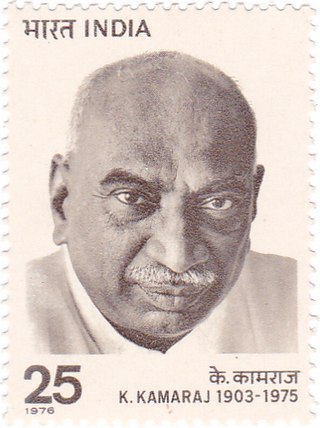
New Delhi is the capital of India and a part of the National Capital Territory of Delhi (NCT). New Delhi is the seat of all three branches of the government of India, hosting the Rashtrapati Bhavan, Parliament House, and the Supreme Court of India. New Delhi is a municipality within the NCT, administered by the NDMC, which covers mostly Lutyens' Delhi and a few adjacent areas. The municipal area is part of a larger administrative district, the New Delhi district.

Education in India is primarily managed by state-run public education system, which fall under the command of the government at three levels: central, state and local. Under various articles of the Indian Constitution and the Right of Children to Free and Compulsory Education Act, 2009, free and compulsory education is provided as a fundamental right to children aged 6 to 14. The approximate ratio of public schools to private schools in India is 7:5.

Karnal (pronunciation is a city located in the state of Haryana, India and is the administrative headquarters of Karnal District. It was used by East India Company army as a refuge during the Indian Rebellion of 1857 in Delhi. The Battle of Karnal between Nader Shah of Persia and the Mughal Empire took place in this city in 1739.

The Kendriya Vidyalaya Sangathan is a system of central government schools in India that are instituted under the aegis of the Ministry of Education, Government of India. As of July 2022, it has a total of 1,248 schools in India, and three abroad in Moscow, Tehran and Kathmandu. It is one of the world's largest chains of schools and also the largest chain of schools in India is controlled by 25 Regional Offices and 05 ZIETs under KVS (HQ).

Bareilly is a city in Bareilly district in the Indian state of Uttar Pradesh. It is among the largest metropolises in Western Uttar Pradesh and is the centre of the Bareilly division as well as the historical region of Rohilkhand. The city lies in the Indo-Gangetic Plains, about 252 kilometres (157 mi) north west of the state capital, Lucknow, and 265 kilometres (165 mi) east of the national capital, New Delhi. With a population of 898,167 in 2011, it is the eighth most populous city in the state, seventeenth in northern India and fifty-fourth in India. It is located on the bank of Ramganga River and is the site of the Ramganga Barrage built for canal irrigation.
Army Public Schools (APS) is a system of private schools established for imparting education to the children of the Indian armed forces personnel. With 137 schools throughout the country, it is one of the largest chains of schools in India. It is controlled by the Army Welfare Education Society (AWES), which was established in 1983, has over the years established more than 135 Army public schools and 249 Army pre-primary schools across India, and also several institutions of higher education.
The Delhi Public School Society or DPS Society is a chain of schools. The descriptor "Public School" references the model of the long-established public schools in the United Kingdom. The Delhi Public School Society is the administrative authority for all its institutions in India and abroad.

Jawaharlal Nehru University (JNU) is a public major research university located in New Delhi, India. It was established in 1969 and named after Jawaharlal Nehru, India's first Prime Minister. The university is known for leading faculties and research emphasis on social sciences and applied sciences.

University Grants Commission (UGC) is a statutory body set up by the Department of Higher Education, Ministry of Education, Government of India in accordance to the UGC Act 1956 and is charged with coordination, determination and maintenance of standards of higher education in India. It provides recognition to universities in India, and disbursements of funds to such recognized universities and colleges. The headquarters are in New Delhi, and it has six regional centres in Pune, Bhopal, Kolkata, Hyderabad, Guwahati and Bangalore. A proposal to replace it with another new regulatory body called HECI is under consideration by the Government of India. The UGC provides doctoral scholarships to all those who clear JRF in the National Eligibility Test. On an average, each year ₹725 crore (US$91 million) is spent on doctoral and post-doctoral fellowships by the commission.

The Air Force School (TAFS), formerly known as Air Force Central School (AFCS), was set up primarily to provide education to the children of Indian Air Force personnel.

Captain Anuj Nayyar, MVC was an Indian Army officer of 17 Jat who was posthumously awarded the Maha Vir Chakra, India's second highest gallantry award, for exemplary valour in combat during operations in the Kargil War in 1999.

Greater Noida is a planned city located in Gautam Buddha Nagar district of the Indian state of Uttar Pradesh. The city was created as an extension to Noida area under the UP Industrial Area Development Act, 1976. Situated 30 km (19 mi) south-east of the capital city of New Delhi, it takes around 30 minutes to travel between the cities via the Noida-Greater Noida Expressway. The city is administered by Greater Noida Industrial Development Authority (GNIDA).

Rashtriya Military School Chail is a residential school in Himachal Pradesh, India, established after the First World War in 1922 with a donation of ₹250,000 from King George V’s patriotic fund. The school's origins lie with the establishment of King George's Royal Indian Military School in Jullunder, Punjab, in 1925. The foundation stone of this school was laid in the Jullunder Cantonment by King George V in February 1922, and the school started functioning in 1925. The school was moved to its present location in Chail, Himachal Pradesh, in 1960. Cadets are known as Georgians after their founder's father.

Kumaraswami Kamaraj, popularly known as Kamarajar was an Indian independence activist and politician who served as the Chief Minister of Madras State from 13 April 1954 to 2 October 1963. He was the founder and the president of the Indian National Congress (Organisation), widely acknowledged as the "Kingmaker" in Indian politics during the 1960s. He also served as the president of the Indian National Congress for two terms i.e. four years between 1964–1967 and was responsible for the elevation of Lal Bahadur Shastri to the position of Prime Minister of India after Nehru's death and Indira Gandhi after Shastri's death. He was the Member of Parliament, Lok Sabha during 1952–1954 and 1969–1975. He was known for his simplicity and integrity. He played a major role in developing the infrastructure of the Madras state and worked to improve the quality of life of the needy and the disadvantaged.
Delhi Public School, R. K. Puram is a co-educational day and private boarding school educating pupils from 6th to 12th grade, located in the South Delhi district of New Delhi, India. It was founded in 1972 and was the second Delhi Public School to be established after Delhi Public School, Mathura Road.
Education is based on three-tier model which includes primary schools, followed by secondary schools and tertiary education at universities or other institutes of same level. Education Department of the Government of Delhi is a premier body which looks into the educational affairs.the RTE right to education also describes children from the age of 6 to 14 have to cumpulsolarily need to be educated. 25% of the seats in all private schools are also reserved for the under-privileged children. Tertiary education is administrated by the Directorate of Higher Education.

Manish Sisodia is an Indian politician and Deputy Chief Minister of Government of Delhi. He has been the Deputy Chief Minister of Delhi since February 2015. He is also an elected MLA from Patparganj constituency. In Government of NCT of Delhi, he holds the portfolios of Education, Higher Education, Technical Education, Public Works Department, Labour, Finance, Planning, Excise, GST, Vigilance, Services, Tourism, Land & Building, Art, Culture & Language.
Hisar Military Station, established in 15 November 1982 at Hisar in Haryana state of India, is the base headquarters of the 33rd Armoured Division of Mathura-headquartered I Corps strike battle formation of Jaipur-headquartered South Western Command of Indian Army.

Meenakshi Lekhi is an Indian politician and the current Minister of State for External Affairs and Culture of India from 7 July 2021. She is a Member of Parliament from New Delhi Parliamentary constituency in the 16th and 17th Lok Sabha from the Bharatiya Janata Party. She is also a lawyer in the Supreme Court of India.
















